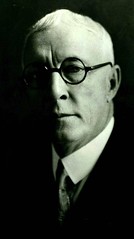Clifford Hewitt Chinese Mint collection, 1930 - 1971
Creator
- Name
- Hewitt, Clifford, 1869-1942
- Abstract
- Clifford Hewitt (1869-1942) of Philadelphia, was born in Hazleton, Pennsylvania. He was chief mechanical engineer for the U.S. Mint and was instrumental in projects involving the building and equipping of the mints of Philadelphia, Denver, Manila, and Shanghai.
Administrative Information
Access
Collection open to all researchers.
Preferred Citation
Clifford Hewitt Chinese Mint collection, 1930-1934, 1971, Archives, American Numismatic Society.
Restrictions
Copyright restrictions may apply. Permission to publish or reproduce must be secured from the American Numismatic Society.
Biographical Note
Clifford Hewitt (1869-1942) of Philadelphia, was born in Hazleton, Pennsylvania. He was chief mechanical engineer for the U.S. Mint and was instrumental in projects involving the building and equipping of the mints of Philadelphia, Denver, Manila, and Shanghai. He also built and installed a mint exhibit at the St. Louis Exposition of 1904 and designed coins, such as the Wilson Dollar commemorating the opening of the Manila Mint in 1920 and a Sun Yet Sen coin for the opening of the Chinese Mint in 1933. Hewitt was the son of Isaac Hewitt and grandson of Thomas Hewitt, both early railroad engineers. Clifford began his training with the Janesville Ironworks in Pennsylvania and went on to graduate from the Franklin Institute of Mechanical Engineering in Philadelphia in 1893. He oversaw the design and building of the Manila Mint, the only U.S. mint established outside of the continental United States, and was then contracted by the Chinese government to serve as technical mint expert for the Shanghai mint project, a position he held from 1920 to 1933, the year the mint opened. He later retired to San Diego.
Scope and Content Note
Collection of materials relating to Hewitt’s work on the Chinese Mint at Shanghai, including Hewitt’s original correspondence and related items (1930-1934), as well as photographs, descriptive labels, and other materials from an exhibit on Hewitt prepared by Edwin P. Janzen for an American Numismatic Association convention in 1971. Hewitt’s letters, telegrams, and cables concern coin designs, metal composition, the proposed change from the Chinese tael to the dollar, and the obtaining of dies and coin blanks. Includes instructions for coin production and for the avoidance of counterfeiting. Correspondents include the U.S. Mint (Philadelphia), the American Trading Company (Shanghai), International Nickel Company (New York City), and Scovill Manufacturing Company (Waterbury, Connecticut). Materials from the later exhibition include photographic prints, negatives, and contact sheets of pictures of coins, Hewitt, and the mint building. Also present are the U.S. Department of Commerce booklet The Marketing of Nickel (1930), design drawings signed by Hewitt for the reverse and obverse of subsidiary coins (1930), newspaper clippings on the opening of the Chinese Mint (1933), a postcard with a picture of the mint, a Chinese name stamp in a case with a note that reads “Lott H. T. Wei, Vice Director of Central Mint, 1929, and embossed letterhead of medalist Adam Pietz along with Hewitt’s penciled design for similar letterhead.”
Related Entities
Organization
Genre/Format
Place
